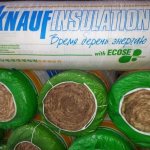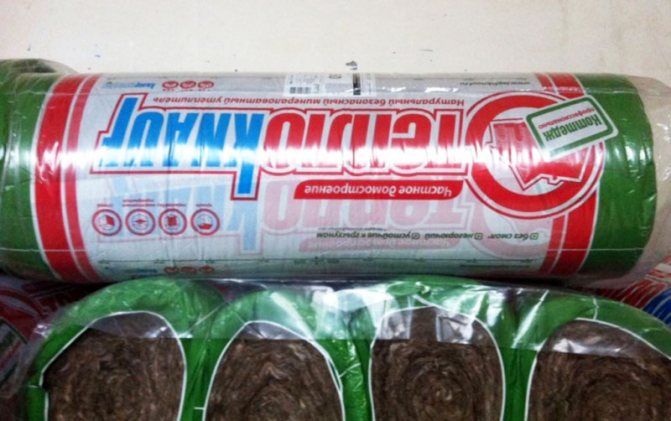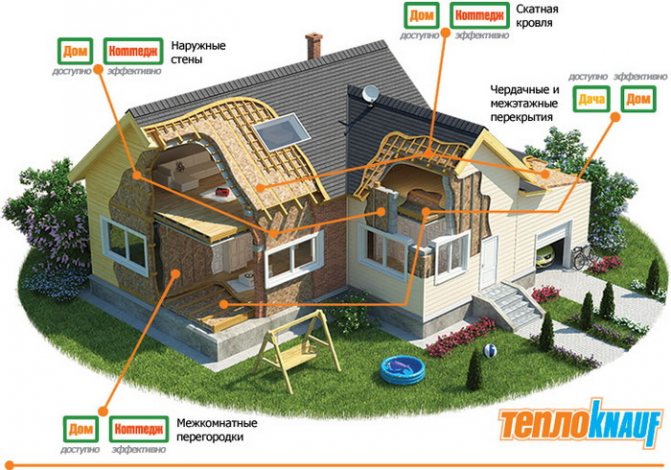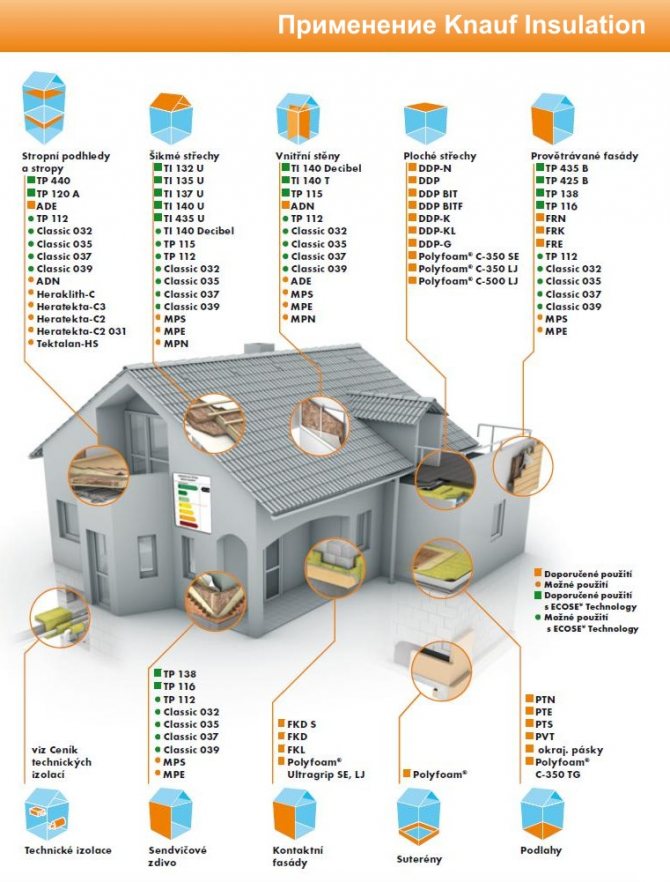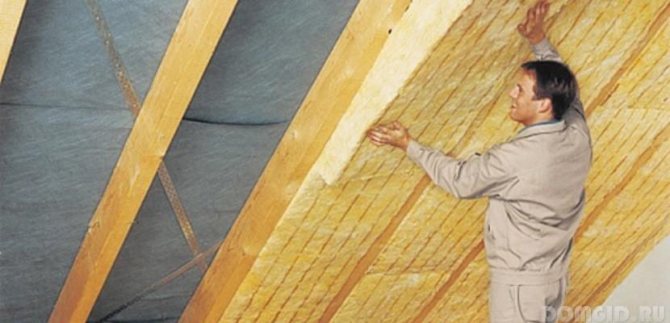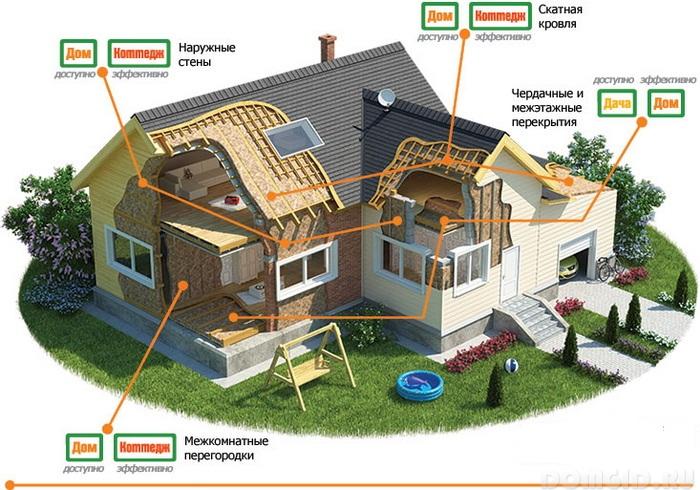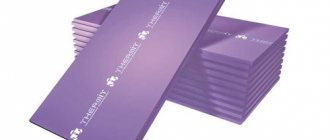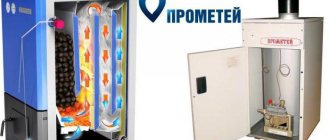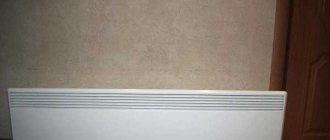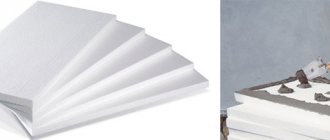Areas of use

The manufacturer has developed special modifications of insulation for any construction needs, differing in density, shape and size. Minvata KNAUF will find application anywhere:
- Can be used for roof insulation. (Ventilated or non-ventilated)
- Warming and soundproofing of the floor of the premises.
- Thermal insulation of the basement and basement of buildings, in order to maintain the stability of the soil in winter.
- External and internal insulation of walls of various buildings.
- Thermal insulation of balconies, basements and loggias
- Prevention of freezing of non-residential premises, production areas and warehouses.
- Thermal insulation of air conditioning and ventilation systems.
Due to the vastness of the assortment, you can find the best option for Knauf insulation for any purpose. The main varieties of Knauf mineral wool and their properties are described below.
Benefits of mineral slabs
For thermal insulation of a house or summer cottage, Knauf mineral plates are chosen more often than other heaters and there are good reasons for this. The material really has obvious advantages, which include:
- The minimum coefficient of thermal conductivity, which allows you to maintain an optimal microclimate in the room after insulation with a reduction in heat consumption costs.
- Excellent sound absorption performance.
- Fire resistance - Knauf mineral wool slabs belong to the group of non-combustible materials, which is especially important for the insulation of residential buildings, summer cottages and other structures.
- Light weight - the load on structures using Knauf mineral wool is minimal.
- No shrinkage - even after the expiration date (50 years), the material retains its original shape and functionality.
- Simple and quick installation - Knauf mineral wool insulation technology will be understandable even for a beginner.
- Complete environmental friendliness due to the absence of toxins and dyes in the composition of mineral wool.


Of the minuses, one can note the higher cost of mineral slabs compared to competitive products, which, however, is justified by their high technical characteristics and long service life.
Useful properties of insulation
The produced heat insulators fully meet the requirements of consumers, providing high-quality heat saving and sound insulation.
The line of products used for thermal protection of buildings and structures includes products based on inorganic fibers and expanded polystyrene.
Knauf heaters have technical characteristics that allow them to be used for thermal insulation of any part of the house.
Advantages of Knauf heaters
Minwata Knauf is famous for its rich assortment
1. The thermal conductivity coefficient of Knauf mineral wool is small, due to which it is possible to keep warm in the house in the most severe frosts.
2. The level of sound absorption is high, so KNAUF mineral wool is good to use for soundproofing rooms from irritating street noise.
3. Resistance to fire, according to the class of fire resistance, the insulation belongs to non-combustible materials (NG) that protect against the spread of fire.
4. The slabs of the material weigh very little, and after a long-term operation, the material does not shrink, but the material lasts up to 50 years.
5. It is easy to install the insulation, it is a pleasure to work with such material. The technology for installing insulation is no more complicated than laying a Knauf superfloor on a wooden floor with your own hands.
6. Thermal insulation, carried out according to the manufacturer's recommendation, cuts heating costs in half.
7. In the manufacture of the manufacturer does not use dyes. The insulation is environmentally friendly and safe.
But, the material still has drawbacks, unfortunately, it is expensive and not everyone can afford to buy Knauf insulation. In addition, heaters are fiberglass, with all the resulting disadvantages - when working, you must use personal protective equipment. We talked about this in more detail in the material: Technical characteristics of mineral wool, selection criteria.
HeatKnauf in individual housing construction
Natural insulation Teploknauf Cottage and Teploknauf Cottage plus have a three-layer structure, therefore, the protection of premises occurs in three directions: from loud sounds, from humid and cold air. Thermal insulation is used to protect the surfaces of walls, ceilings and floors, roofs and attics, basements and foundations. At retail and wholesale, Knauf thermal insulation is delivered in rolls or in plates with a canvas (plate) thickness of 50 mm, a length of 1230 mm and a product width of 610 mm. The rolled heat knauf has a length of 6148 mm and a width of 1220 mm. Insulation "TeploKNAUF Cottage +" is produced only in the form of plates with a thickness of 100 mm with other parameters similar to the parameters of heat-knauf insulation.
| Technical specifications | Plates Cottage plus Knauf | Rolls Cottage Plus | Cottage plus in slabs |
| Thermal conductivity index at + 100C, W / m • C | 0,037 | ||
| Sound insulation index С111, RW (W) | 45,0 | ||
| Flammability of insulation rolls and plates | NG Group | ||
| Length in millimeters | 1230,0 | 6148,0 | 1230,0 |
| Width | 610,0 | 1220,0 | 610,0 |
| Thickness | 50,0 | 50,0 | 100,0 |
| Package volume, in cubic meters | 0,75 | 0,75 | 0,6 |
| Total container area, in square meters | 15,0 | 15,0 | 6,0 |
| Units in a container | 20,0 | 2,0 | 8,0 |
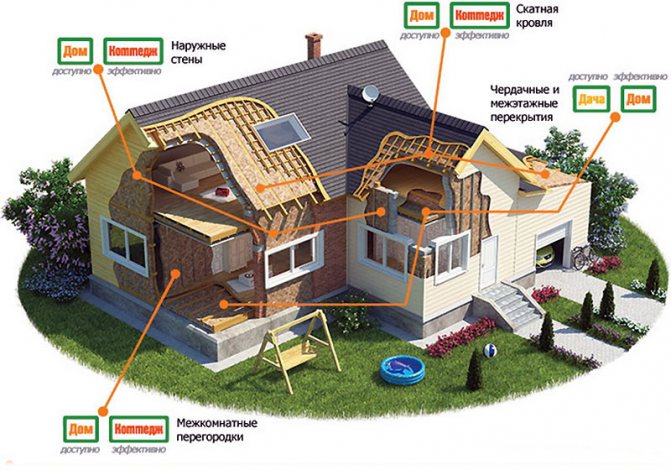

Scope of thermal insulation TeploKNAUF Cottage +
Thermal insulation HeatKNAUF House and HeatKNAUF House +
The multidisciplinary insulation of the Teploknauf House is produced according to the innovative technology "3D-elasticity", and the impressive parameters of this insulation material are shown in the table below. The ability of insulation to adhere so tightly to the surface to be insulated does not give the slightest opportunity to appear "cold bridges". The advantage of the TeploKNAUF House material, which is made twice as thick (not 50, but 100 mm), is in saving thermal insulation on any surfaces. The product is produced in the form of slabs and rolls.
| Technical properties | Teploknauf House | Teploknauf House Plus |
| Thermal conductivity index at + 100C, W / m • C | 0,040 | |
| Noise insulation index С111, RW (W) | 45,0 | |
| Flammability of heat insulators in slabs and rolls | NG Group | |
| Length in mm | 1230,0 | 6148,0 |
| Width | 610,0 | 1220,0 |
| Thickness | 50,0 | 100,0 |
| Package volume, in cubic meters | 0,6 | 0,6 |
| Total container area, in square meters | 12,0 | 6,0 |
| Units in a container | 16,0 | 8,0 |


Thermal insulation TeploKNAUF House +
Teploknauf Dacha
This insulation material is produced in rolls, which makes it possible to insulate large areas more conveniently and much faster, for example, the ceiling in the attic or roof surfaces, interfloor ceilings and floors in the basement. In individual construction, it is often used to insulate outbuildings and superstructures - sheds, attics, verandas, terraces, pavilions, etc.
| Technical specifications | Teploknauf Dacha |
| Thermal conductivity index at + 100C, W / m • C | 0,044 |
| Noise insulation index С111, RW (W) | 45,0 |
| Flammability of a heat insulator in any form | NG group (non-combustible material) |
| Length in mm | 7380,0 |
| Width | 1220,0 |
| Thickness | 50,0 |
| Package volume, in cubic meters | 0,9 |
| Total container area, in square meters | 18,0 |
| Units in a container | 2,0 |


Thermal insulation Teploknauf Summer cottage
KNAUF Insulation insulation
Knauf Insulation Thermo Cooker-037. From the name it is clear that this insulation is produced in slabs, a description of the characteristics of the material is given below. Insulation is designed to protect pitched roofing surfaces, walls, ceilings, log floors, partitions, inclined surfaces of internal structures of the house. In addition to high performance in terms of thermal insulation, Thermo Plate-037 deters noise well. For fixing the slabs, a metal, wooden frame or a closed space is used, for example, between beams or lags of partitions.
| Technical properties | Knauf Insulation Thermo Cooker-037 |
| Thermal conductivity index at + 100C, W / m • C | 0,038 |
| Density Knauf Insulation | 15 kg / m3 |
| Flammability Knauf Insulation | NG group (non-combustible material) |
| Length in mm | 1250,0 |
| Slab width | 600,0 |
| Thickness of slabs | 50.0 and 100.0 |
| Package volume, in cubic meters | 0,9 |
| Total container area, in square meters | 9.0 and 18.0 |
| Units in a container | 12.0 and 24.0 |
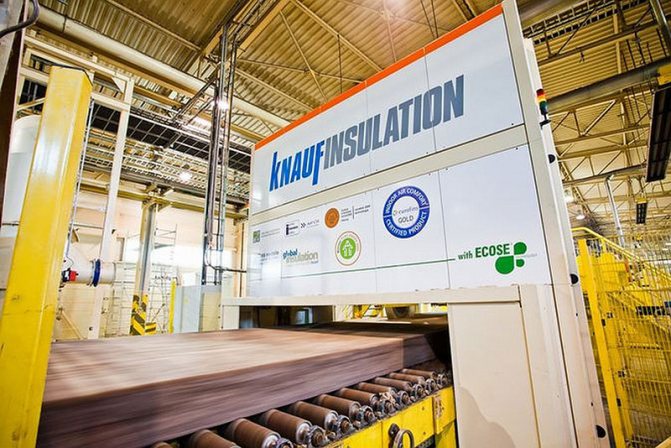

Knauf Insulation Production
TeploKnauf - a line of heaters for private housing construction
For the construction of low-rise residential buildings and a number of outbuildings, Knauf has released a line of TeploKnauf heaters. They have various purposes, sizes and some technical characteristics. At the same time, they are united by the presence of an effective water-repellent impregnation, minimum service life of 50 years and lightness.
HeatKnauf for roof and exterior wall insulation
Heat loss through the roof and outside walls can be quite high. To prevent them, Knauf offers several insulation options.
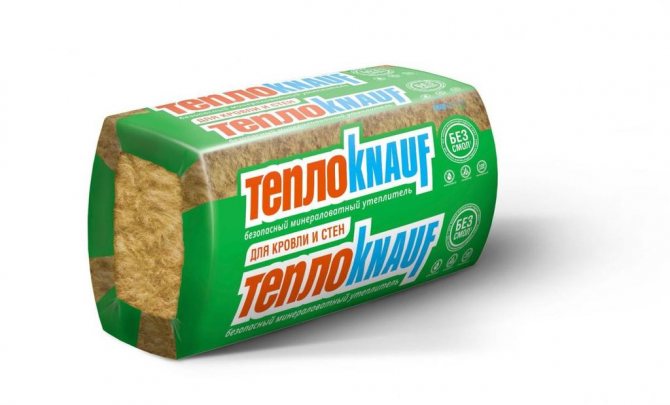

Thus, TeploKnauf for Cottage is suitable for insulating pitched roofs and exterior walls. In this case, mineral wool is represented by slabs 50 and 100 mm thick. With a length of 1 230 mm and a width of 610 mm, they are easy to use even for non-professionals, which is confirmed by numerous consumer reviews.
There is also TeploKnauf for Cottages in the "mini" format... These are slabs for walls and roofs 50 mm thick, 1000 mm long. They are packed twice as compact as the standard version, so they are easier to transport.
Useful: Plasterboard ceiling: do-it-yourself plating
With the help of Knauf Cottage you can insulate:
- external walls of frame buildings;
- walls for ventilated facades;
- facade for facing with bricks or siding.
A separate position is occupied by TeploKnauf for Roofing. This is a roll insulation with a thickness of 50 or 150 mm. The roll lengths are 6,148 and 5,500 mm, respectively.
HeatKnauf for slabs - one solution for heat and sound insulation
High-quality insulation of the floor, ceiling and attic floor plays no less a role in the formation of the internal microclimate than the insulation of the outer walls. It provides not only good heat saving, but also effective sound absorption.


For the corresponding work, the manufacturer offers the consumer TeploKnauf for Ceiling. It is suitable for insulating both timber and concrete structures. The thickness of the rolled mineral wool is 50 or 100 mm. For this reason, it perfectly complements the TeploKnauf Cottage. The rolls are 7,380 mm long and 1,220 mm wide.
Also thermal insulation "For Overlaps" is presented in a mini-format. These are rolls 50 mm thick and only 60 cm wide. They are compactly rolled up, so they take up little space even in a passenger car.
Since when working with ceilings, not only insulation is important, but also providing increased noise absorption, it is worth paying attention to sister product of the company - AcustiKnauf... Its production is also based on Ecose technology.
The improved sound insulation effect is achieved by the long and extra thin mineral wool fibers. Knauf Acoustic is suitable for acoustic floors, suspended ceilings and partition walls.
Other HeatKnauf Products
In the line of insulation TeploKnauf there are products “not for everyone”. We are talking about TeploKnauf Nord - thermal insulation material for regions with extremely harsh winters. Its features are the integrity of the thermomat (one layer), the increased number of fibers and their increased elasticity.
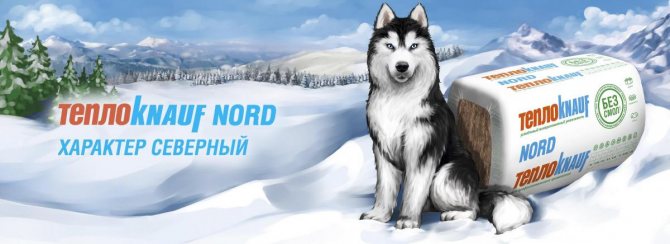

As a result, Nord insulation:
- 15% warmer than a standard Overlap Thermomat;
- 40% more elastic compared to the main line of TeploKnauf;
- 10% more moisture resistant.
The thickness of Nordic mineral wool is 50 mm. This makes it versatile, suitable for insulation of roofs, ceilings, walls, floors.
A number of products have been discontinued, which is indicated on the official website of the company. However, sometimes they can be found among the leftovers in some hardware stores:
- HeatKnauf Premium. Differs in increased strength, resistance to deformation.
- HeatKnauf Home and Home +. Elastic slab material, suitable for insulation of ceilings, walls, roofs.
- Knauf Dacha is a budgetary roll insulation 50 mm thick for country houses, outbuildings in garden plots.
- Knauf Expert is an affordable solution designed specifically for DIY stores.
- Knauf ECOroll (Knauf Ekoroll). A budget option for horizontal surfaces.
The TeploKnauf product line is quite large, so choosing the best option is not difficult.
Useful: Types and areas of application of foil insulation
Heaters HeatKnauf
There are several varieties of Teploknauf heaters. Each of them is designed for its own type of building, differs in thermal insulation properties and, of course, in price.
Knauf Cottage
In addition to thermal insulation, it is distinguished by high sound insulation and waterproofing properties. It is a versatile material that can provide thermal insulation for both roofs and walls.
It is mainly used for country houses. It is produced in the form of 50 mm thick slabs.
Knauf Cottage +
These heaters have technical characteristics similar to the previous type, however, the thickness of the plates is 2 times greater, which makes the production of insulation works in cold areas more economical and faster (it is cheaper and easier to mount one thick layer than two thin ones).
Knauf Dacha
A relatively inexpensive version of insulation designed for buildings with occasional presence of people - for example, summer cottages, sheds or summer kitchens.
In severe frost, such products are ineffective.
Knauf House
The improved technical characteristics of these materials make it possible to use them to improve the thermal insulation properties of both private houses and apartments. The thickness of the slabs is 50 mm.
Knauf House +
The properties are the same as those of "Knauf House", but the thickness is already 100 mm, due to which the materials are more profitable to use in areas with a lower average annual temperature.
Heaters TeploKnauf
The TeploKnauf line is focused on construction, insulation and sound insulation of private houses, as well as insulation of parts of apartments. Professional construction skills are not required to work with it. It is available in two types of convenient packaging: rolls and sheets assembled in blocks. Knauf slab insulation is usually taken for wall insulation using frame technology, it is very convenient to lay it between vertical posts.
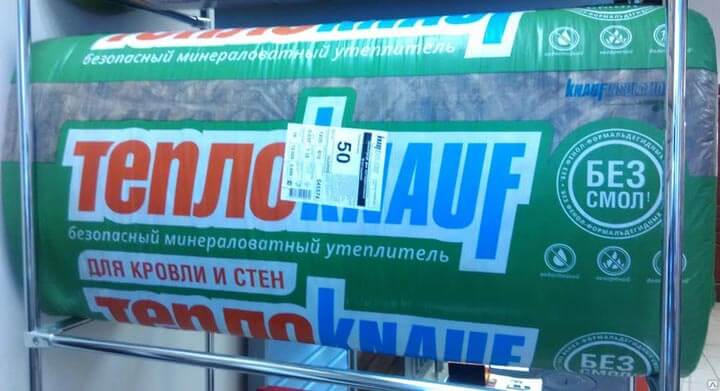

Teploknauf insulation for walls and roofs.
The entire line of TeploKnauf includes three products: TeploKnauf Dacha, TeploKnauf Cottage and TeploKnauf Dom. Let's understand the features of each product.
TeploKnauf Cottage
Heater Knauf Cottage has two release options: TeploKnauf Cottage and TeploKnauf Cottage +. Of the entire line for private housebuilding, this product has the highest performance in heat and sound insulation.
The thickness of the TeploKnauf Cottage mineral wool layer is 50 mm, the dimensions of the slab are 1230 × 610 mm, the dimensions of the canvas in rolls are 6148x1220 mm. Insulation knauf 50 mm in one layer allows you to reliably insulate houses in the southern and central regions of Russia, for Siberia and the Northern territories either a 100 mm thick insulation or a double layer of 50 is required.
On a note. The material is universal, suitable for complex insulation of any structures of a private house, as well as for sound insulation in interior partitions.
TeploKnauf Cottage + has an increased plate thickness - up to 100 mm. Knauf insulation 100 mm allows faster installation. The form of release is exclusively slabs, in rolls TeploKnauf Cottage + is not for sale.
Parameters of basalt wool TeploKnauf Cottage.
- Thermal conductivity: low - 0.037
- Noise isolation: good - index 45
- Refractoriness: non-combustible material, NG
- Dimensions: in rolls 6148 * 1220 * 50 mm, in slabs 610 * 1220 * 50 mm
- Package volume: in rolls and in packaging 0.75 m³
- Material area: 15 m2
- Package quantity: plates - 20 pcs, rolls - 2 pcs.
- The packaging is marked in red.
TeploKnauf Dacha
TeploKnauf Dacha is focused on the insulation of buildings in which it is not planned to winter, therefore, here the thermal insulation properties are the smallest of the entire line. The material is used to insulate summer houses, sheds, change houses, guest houses. Release form - exclusively in rolls.
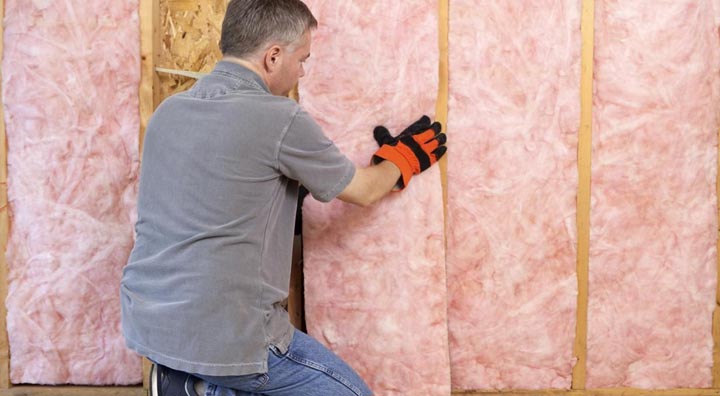

Installation of mineral wool.
Parameters of basalt wool TeploKnauf Dacha
- Thermal conductivity: high - 0.044
- Noise isolation: good - index 45
- Refractoriness: non-combustible material, NG
- Dimensions: in rolls 7380 * 1220 * 50 mm
- Packaged volume: rolls and packs 0.9 m³
- Material area: 18 m2
- Package quantity: rolls - 2 pcs.
- The packaging is marked in yellow.
TeploKnauf House
Heater Knauf House is also produced in two versions: TeploKnauf Dom and TeploKnauf Dom +. Scope of application - for the insulation of private houses located in a moderately cold climate, as well as non-residential premises to protect them from freezing - balconies, loggias, basements, buildings for farm animals.
The material has three main advantages: heat, sound and waterproofing, and also has increased elasticity. TeploKnauf House + differs from TeploKnauf House in its exceptionally doubled thickness: 100 mm versus 50 mm.
Parameters of basalt wool TeploKnauf Dom.
- Thermal conductivity: average - 0.040
- Noise isolation: good - index 45
- Refractoriness: non-combustible material, NG
- Dimensions: in rolls 6148 * 1220 * 50 mm, in slabs 610 * 1220 * 50 mm
- Package volume: in rolls and in packaging 0.6 m³
- Material area: 12 m2
- Package quantity: plates - 16 pcs.
- The packaging is marked in orange.
Knauf Insulation Expert Series
Heat-insulating materials "Knauf" of the Insulation series have improved strength, sound- and heat-insulating parameters, and are used for the same purposes as TeploKnauf.
However, their assortment is much wider.
Thermo Plate 037
Excellent heat insulators, available in the form of slabs with an area of 0.75 sq. m. Designed for insulation of any enclosing structures - from roofs to floors on logs.
Thermo Roll 040
Suitable for thermal insulation of horizontal surfaces with a low load - floor slabs, roofs and log floors above the ground or basement. The form of release is a mat (roll or roll) with a size of 1.2 × 10 m, due to which the material is easily rolled up, transported and stored.
Insulation Pitched roof
Produced in rolls or in the form of slabs, materials with high waterproofing properties, due to which they do not absorb moisture at all. With their help, pitched roofs of residential, industrial and office premises are insulated. There are the following main varieties of this type of Knauf insulation:
- mats Thermo Roll 037A having a length of 5.5 and 9 m and a width of 1.2 m;
- plates Thermo Plate 037A and 034A with dimensions of 0.61 × 1.25 m;
- Thermo Roll 034A, with width and length, respectively, 1.2 and 5.0 m.
Facade
This type of insulation of the Insulation Expert series does not absorb moisture thanks to Aquastatik technology and may well be used not only for interior, but also for exterior decoration. It is produced in two modifications, 032A and 034A, differing in thermal conductivity, but the same size - 0.6 × 1.25 m. The thickness of the slabs is from 50 to 100 mm.
The thermal conductivity coefficients of all these Knauf materials are easily determined from the number in the brand name - for example, 037 means an indicator equal to 0.037 W / m2 • K. The figure 040 indicates the value of the coefficient equal to 0.04 W / m2 • K. And the standard thickness of the slabs is 0.05 and 0.1 m, except for the option for a pitched roof Roll 037A, the thickness of which can be 0.15 m.
Knauf Ekoroll
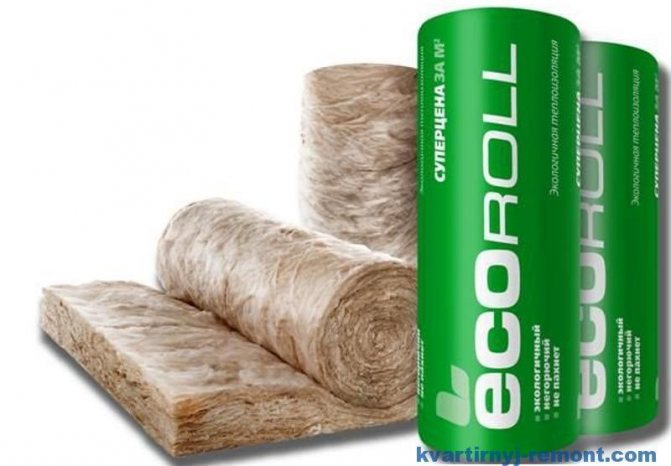

This brand of roll insulation meets all of the above characteristics - high heat and sound insulation, 3D elasticity technology, environmental friendliness, fire resistance and protection from rodents. Mineral fiber in the composition of the product is characterized by high vapor permeability, which allows the house to "breathe" and maintain a comfortable indoor microclimate.
Minvata Knauf Ekoroll is recommended mainly for thermal insulation of horizontal structures.
It is made in the form of large-volume rolls, in the KNAUF product line it is one of the most budgetary options. The size of a regular roll is 8.2 mx 1.22 m. Minvata in a roll is pressed in such a way that when unpacked it increases in volume almost 6 times.Soft and easy to use, this cotton wool is used in structures that are not subject to stress - with its help they insulate and soundproof:
- frame houses;
- pitched roofs;
- attic;
- overlapping between floors;
- interior partitions;
- floors on logs.
This affordable material is almost universal when insulating a residential building. Its density is slightly lower than that of other Knauf products - 10.5 kg / m3. A large area of insulation in a roll allows it to be laid with a minimum number of joints, which significantly reduces heat loss.
Heaters
-802 votes
+
Voice for!
—
Against!
In the field of construction, Knauf is considered to be one of the most famous manufacturers of insulation materials. It is the materials from this brand that are in high demand among the consumer, which indicates the high quality of goods and the affordable price of resources. The range of materials for finishing works from this brand includes a huge selection of various raw materials, divided into special lines, which will be discussed later in the article. In the thematic blocks, the varieties of Knauf heaters, their areas of application, as well as detailed technical characteristics of materials are considered.
Table of contents:
- Scopes of Knauf heaters
- Varieties of knauf heaters
- Knauf Insulation EXPERT Product Specifications
- Features of the TeploKnauf line
- Knauf Therm characteristics
- How to choose the right knauf insulation
Scopes of Knauf heaters
Since 1932, the construction market has been selling goods from the German company "Knauf", specializing in the manufacture of insulation from mineral wool and expanded polystyrene. Today, this raw material is considered very common and in demand, since it is used in the construction of various objects, commercial, private, industrial, etc. Mineral wool of this brand is appreciated not only among small buyers, but also in the field of application by large construction companies, since the products are considered absolutely safe for human health. Knauf thermal insulation rolls are made taking into account innovative technologies, which helps to make them highly efficient, of high quality and long-term.
Knauf insulation, the price of which, in comparison with other insulating raw materials, is quite democratic, is made on the basis of basalt wool and glass wool with various impurities, which allows the manufacturer to sell the product not only in rolls, but also in the form of sprayed and filling plates. These resources have found their application in the areas of thermal insulation organization for:
- exterior and interior walls of cottages;
- ventilated facades of houses;
- pitched roofs and floors of summer cottages, etc.
We can say that, depending on the purpose of use, the choice of the desired material depends, which are divided into several varieties, read about this below.
Varieties of knauf heaters
Depending on the size and purpose of the construction site, professionals select the type of knauf mineral wool required for work. It is worth noting that the range of heaters of this brand offers whole lines of insulators, for different purposes, with different technical features. In turn, these groups are divided into varieties, see the table.
| Varieties of knauf heaters | |
| Teploknauf | Materials of this production line are actively used in the process of installing thermal insulation in private houses. They are used for finishing roofs, internal partitions, etc. |
| Knauf Insulation EXPERT | Raw materials of this variety are in demand at large construction projects, where its required rate is not one or two rolls, but hundreds of square meters. |
| Knauf Therm | This line includes thermoplates intended for insulation of facades, walls, floors, etc. Materials from this group are distinguished by a high level of strength and are excellent for thermal insulation of foundations. |
It is worth saying that regardless of which variety this or that mineral wool belongs to, there are characteristics that are comparable to any of the above groups. So, all Knauf brand heaters have the following positive characteristics:
- absorb sounds well, allow you to equip the room with additional noise insulation;
- have a low level of thermal conductivity, retain heat even during the most severe frosts;
- do not lend themselves to damage by rodents, due to which they have a fairly long term of use;
- easy to install, do not cause discomfort on the skin, not prickly;
- do not lose their primary forms during transportation;
- are light enough;
- have a standard brown color, since various dyes are not used in the production of knauf, by
- this quality material can be recognized by its shade.
It is worth noting that the vapor permeability indicators of mineral wool from a German manufacturer are no more than 0.55 mg / mhPa, while the thermal conductivity coefficient varies from 0.034-0.040 W / mK.
Knauf Insulation EXPERT Product Specifications
The fiberglass insulation of the Knauf Insulation EXPERT line is a range of products for consumers who prefer to do their own construction tasks. As a rule, it is distributed in all hardware stores, and Knauf insulation, the official website of which is easy to find on the Internet, can be ordered via the Internet, delivered to the post office or to your home. Materials from this line are considered absolutely safe, since they do not include harmful phenol-formaldehyde substances. You can also add to a number of their advantages:
- comfortable packaging that simplifies transportation and installation of the insulator;
- when choosing a material, the consumer can get acquainted with its main features and characteristics right on the package;
- Insulation rolls from this line, which are intended for roof processing, have an improved, increased thickness, which does not require additional thermal insulation.
For attic floors, intermediate floors, interior partitions, TEPLOroll 040-15 Expert, TEPLOroll 040-19 Expert, TEPLOroll 040-150-6 Expert, which differ in the area of insulation in the package, in the thickness and width of the material, are considered specially designed.
It should be noted that all materials from the Knauf Insulation EXPERT line, for the production of which glass staple fiber is used, can be used to ensure thermal insulation of the floor over the beams. With the help of slabs and rolls, you can equip suspended ceilings in rooms, since knauf mineral wool is considered universal and is characterized by a low level of water absorption.
Features of the TeploKnauf line
The TeploKnauf mineral wool family is usually divided into the following groups:
- Knauf Dacha;
- Knauf House and House Plus;
- Knauf Cottage.
So, for suburban dwellings that do not imply a permanent stay of tenants there, the manufacturer offers a budget series of materials that are characterized by poor waterproof properties. Raw materials of this quality do not retain heat well in cold weather, so it is better to use it in buildings such as a garage, etc.
Slabs made of mineral wool of the Knauf House and House Plus series are considered denser. Since their thickness ranges from 5 to 10 cm, urban apartments and private residential buildings are considered to be used. The quality indicators of this model can be called average, since the conductivity level of the material is 0.04 W / m ∙ K. The disadvantages of this raw material include poor sound insulation properties. It is worth recalling that mineral wool is a material that belongs to the group of non-combustible.
Excellent qualities are characterized by the Knauf cottage building insulation, which has an additional water-repellent impregnation, so that it can be used without additional installation with film materials.
An important characteristic of the resources of this group can be called a high level of heat saving, which makes it possible to use the material for insulation of roofs, walls, etc. It is equally important to emphasize that the TeploKnauf line is not recommended for use in vertical, loaded structures.
Knauf Therm characteristics
Heaters from the Knauf Therm line can be called highly efficient thermal insulation materials, which are characterized by a low level of water absorption and, at the same time, excellent strength. It is worth explaining that this product line is divided into raw materials for insulating walls, floors, facades, flat roofs, etc. Knauf Term heaters are materials based on expanded polystyrene granules, which in the process of foaming increase in size tenfold. Knauf thermal insulation foam polystyrene plates have the following positive qualities:
- high level of sound insulation;
- absence of harmful chemical compounds;
- the material is not damaged by rodents, mold and fungal diseases do not form on it, does not attract insects, which is no less important;
- slabs are convenient during installation, as they are packaged in compact packages and are lightweight;
- the material is easy to plaster, which cannot be said about the mineral wool from this manufacturer;
- due to the fact that the material does not include phenol-formaldehyde, chromium and other substances, it is possible to work with it without overalls and other protective elements;
- are distinguished by a long operating period.
Knauf term ruf is a polystyrene board with good moisture resistance and strength. They are actively used not only in the process of insulating roofing elements in new buildings, but also as restoration raw materials. They are capable of withstanding large bearing loads, and one person can handle their installation. The standard equipment of this product is presented in packages of 1.2 m³.
For insulation of brick, concrete, aerated concrete structures, it is recommended to use insulation from the Knauf Therm Facade series. The range of materials from this category is represented by slabs of different thicknesses: some (50 - 80 mm) are intended for internal work on thermal insulation of premises, others (100 - 120 mm) are recommended for outdoor use. Warming of foundations should be carried out with construction resources from the knauf flora group. They are actively used in construction work aimed at organizing reliable plinths, blind areas, warm floors, etc.
For warming country houses and carrying out repairs of individual areas, it is recommended to use the universal insulator Term Compak, it not only retains its shape for a long time and withstands heavy loads, but also perfectly resists a humid environment. However, craftsmen need to remember that Knauf heaters based on expanded polystyrene are flammable, so they cannot be used to isolate baths, steam rooms, saunas, etc., it is wiser to use mineral raw materials from this manufacturer for this purpose.
How to choose the right knauf insulation
As practice and analysis of user reviews show, Knauf heaters are reliable, affordable raw materials that allow you to isolate the required private premises or a large object at a level. But those who want to work with this particular material must remember that their choice must be approached carefully. As it turned out from the above information, the entire range of building resources of this brand is divided by purpose, therefore it is important to select it this way and use it in the future.
That is, before buying mineral wool or insulation based on expanded polystyrene, the owner needs to decide on the purpose of purchasing it: for insulation of the floor, facade, walls, etc. Based on this, you should move on to the production line of materials, which determines their quality and cost.
When choosing the best Knauf insulation, the official website of which advertises all products, it is imperative to consult with a competent seller, to be sure, read the certificates for the products, clarify the thermal conductivity indicators, the flammability class, the operational period, etc.
Thus, we can say that the quality of construction work on the organization of thermal insulation with the Knauf company occupies a leading position, because the products of this brand are in demand all over the world and are characterized by the majority of positive responses from consumers. Thanks to the variety of mineral heaters from the manufacturer, everyone can choose the most suitable raw materials for themselves, both in terms of quality and purpose, and in terms of price policy. Correctly selected Knauf mineral components are a worthy solution in any repair business. More detailed information on the topic is given in the video:
Installation features
Preparation of the frame for external wall insulation
When installing mineral wool of the Knauf Cottage brand, it is necessary to follow the manufacturer's recommendations and basic rules so that the result is as ideal as possible. The installation process consists of several stages and includes the installation of the frame, the insulation itself, as well as the application of a vapor barrier film. You can cope with this process on your own if you have skills in the field of construction and finishing work, or entrust the installation to professionals.
Frame
The primary timber frame is required for the direct installation of the insulation on the walls. Without it, the material will not hold. Before installation, the walls are cleaned of unnecessary elements and wood bars are prepared, which are treated with a refractory compound. They are fixed horizontally and vertically on the walls from one corner to another; in the presence of irregularities, special substrates are made from various materials.
The bars are fixed with self-tapping screws 75 mm, each fastener is installed at a distance of at least 40 cm from each other. After installing the first beam, you need to measure 58 cm from it, since the width of the slab is 61 cm, then the second and subsequent beams are fixed in compliance with this distance. The windows are framed with bars horizontally and vertically, taking into account the plane of the wall.
If necessary, you can use additional substrates that allow you to level the surface of the walls and fix all the beams with slabs as securely as possible.
Insulation installation
Insulation installation
Plates are installed starting from the corner, they are slightly squeezed and placed between the beams, then fixed on the wall using special fungi. For one plate, you will need at least 3-5 fungi, taking into account the material in one package, each of them is mounted in a through hole with a diameter of at least 6 mm, made with a perforator or drill. The insulation can be cut to fit the spacers using a paint knife. After filling all the cells between the bars, proceed to the installation of the film.
Installation of vapor barrier film
Mansard roof vapor barrier
The film is necessary to prevent the formation of condensation inside the insulation; if it is present, steam particles simply go outside towards the cold air. It must be installed with the smooth side up, taking into account the instructions, each strip is placed from the bottom up, taking into account an overlap of 10 cm or vertically from the corner. For the most reliable fixing, the film is sewn to the wood of the bars using a construction stapler. Also, the seams must be glued with double-sided tape so that they do not part.After the walls are sewn up, you can start installing the siding.
Siding
For siding, they use bars in the size of 25x50 or 25x100 mm, special self-tapping screws with a length of 35 to 55 mm and a screwdriver. Frame boards are impregnated with a bioprotective solution and cut according to the required length, which should correspond to the length of the boards for the first frame. Next, you need to form the corners and screw them to the horizontal bars on the first frame vertically, the next boards are attached at a distance of at least 25 cm from each other. Following these rules helps to make the structure more durable in addition to the standard insulation procedure.
It is important to always follow the manufacturer's recommendations and not combine materials that are incompatible with each other. In this case, the insulation does an excellent job with its direct and additional functions.
Benefits
The choice of building and finishing materials often becomes a serious problem. The consumer is not always aware of the intricacies of production, he has to be guided by the appearance of the insulation, reviews on the Internet and an attractive price.
However, very different characteristics speak about the quality of the insulation:
- Environmental friendliness. The entire line of warm-knauf heaters is made of natural material - basalt fibers (basalt insulation). This material gives the insulation a gray tint and is absolutely safe for human health.
- High degree of sound insulation and sound insulation.
- Zero fire hazard (non-combustible insulation).
- Due to the increased density of the material, a high level of resistance to aggressive influences and dampness is provided.
- Longer service life.
- Easy to install and handle.
Any insulation has a number of features that should be taken into account. When installing mineral wool, it is imperative to use protective equipment against small particles of glass wool - gloves, goggles and a respirator.
In addition, the layers of insulation are shifted with protective materials. Waterproofing is necessary for any type of insulation. To protect the material from moisture, Knauf uses a unique aquastatic technology, which prevents condensation from entering the slab.
Advantages of Knauf Acoustic plates
The main advantage of the material is its ability to absorb various types of sounds and noises. The soft base captures and absorbs sounds as efficiently as possible. Thin fibers provide good air and steam permeability, which makes it possible to use insulation in rooms with high humidity. The flexible structure helps to insulate and isolate the sound of sewage. The material can be wrapped tightly around the pipe, thereby reducing the noise of the sewer. Cotton wool can be used both for apartments and private houses. Quite often Knauf ceiling sound insulation is used as insulation for roofs, attics and attic.
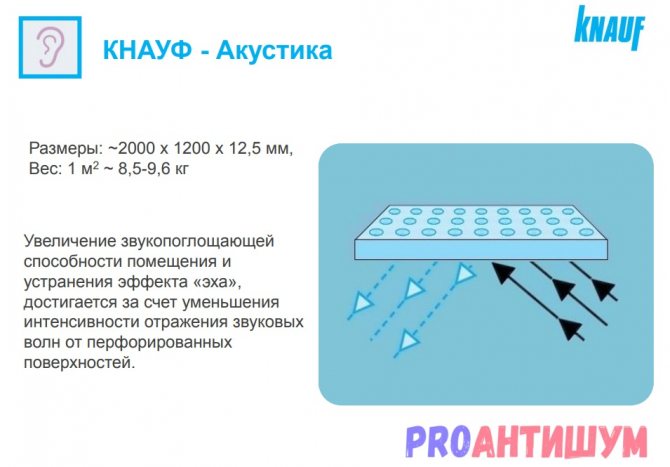

Speaking about the advantages, one cannot fail to note the environmental friendliness of the material. The product is made from natural raw materials, so there are no harmful elements and resins in its composition. Knauf soundproofing walls are odorless, so they are often used in soundproofing residential buildings and public premises.
It is easy and convenient to work with the material. Given the low weight of the material, it does not require special equipment for loading and transportation. One package contains 16 slabs of 1250 * 610 * 50 mm. This number of slabs is enough to cover an area of twelve square meters. To work with slabs, you do not need special equipment or tools, the laying technology is similar to those used for installing basalt or mineral wool.


Knauf soundproofing of the ceiling is carried out using a structure made of aluminum profiles or wooden beams.Due to the parameters of the slabs, the frame base is erected according to generally accepted dimensions with a step width of 60 centimeters. The slabs have the same width, which makes it possible to use sound insulation practically without waste.
Distinctive features
The main distinguishing feature of Knauf acoustic materials is the high quality of products. The production of mats is based on German technology using only high quality equipment. In the aggregate, an ideal soundproofing material is obtained, which has all the necessary qualities and features.
If we compare KNAUF mats, it is important to note that the product has a relatively low cost, which is especially pleasant for a grand renovation. Of course, when comparing cotton wool and gypsum-based boards, the differences will be significant. First, the composition of the material differs. Secondly, a frame is not required for its installation. In addition, the panels can be used as a leveling surface. The sound insulation thickness does not exceed five centimeters, which is ideal for working with small rooms.
Technical characteristics of Knauf heaters
Knauf mineral wool is produced on the basis of basalt fiber and does not contain any acrylic or phenol-formaldehyde compounds. It is safe for humans. Additionally, the material is treated with a water-repellent composition, which provides additional moisture resistance and preservation of heat-shielding characteristics under conditions of use with high humidity.
On a note. When installing insulation, you should not neglect the wind and vapor barrier films. Even with high moisture-repellent characteristics of Knauf heaters, the use of a film or membrane will increase the service life of the material, as well as increase its thermal protective properties.
It is worth noting the technical characteristics of Knauf insulation, which are very important during installation:
- Low weight allows for installation alone, without helpers.
- Convenient packaging in rolls or blocks contains sheets of 50 or 100 mm.
- The material is not prickly and does not cause painful sensations when working with it.
- Knauf mineral wool does not require mandatory respiratory protection.
- The material is easily cut with an ordinary office knife, no special tools are required for work.
- The material itself straightens out in the provided space and fits snugly to the bases: no additional work with seams and joints is required.
Layer-by-layer insulation
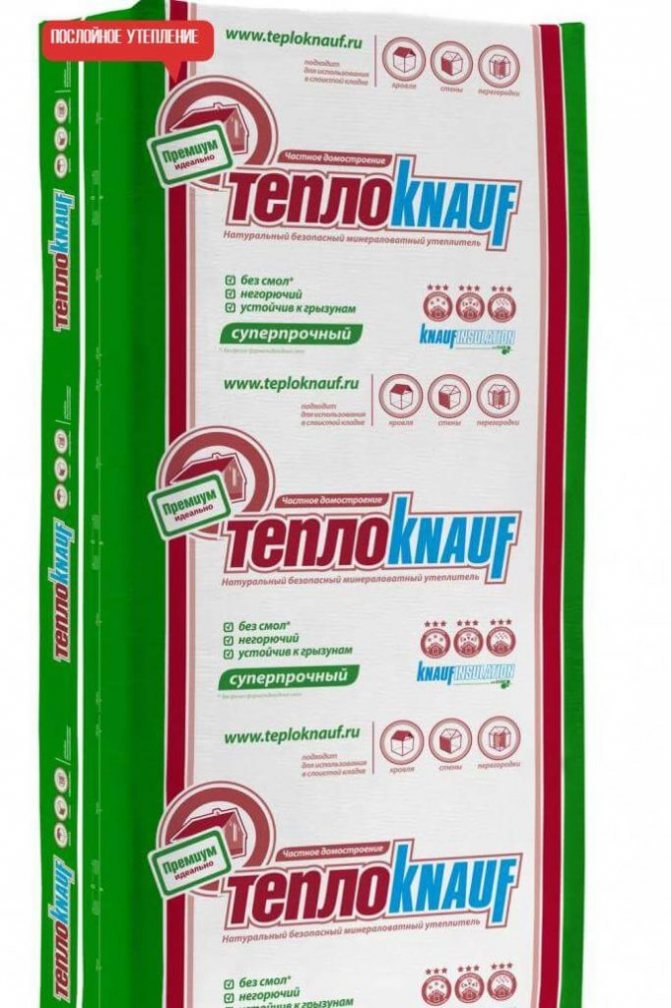

TeploKnauf Premium is the first material developed for use in private households. Does not contain fiberglass. During operation, it does not change its size, does not shrink, which avoids tears in the insulation layer.
Possesses increased heat retention capacity, good sound insulation. Resistant to getting wet. It is used for insulation of enclosing structures, including for layered walls. The minplate has dimensions of 1230x610 mm.
If you need it only for yourself
For ease of use and transportation, TeploKnauf House Mini is produced. The length of the slab is 1 m. Glass wool is not used in production. The main purpose of Knauf House Mini is to insulate enclosing structures that are small in area or even part of them.
For professional use


The use of Knauf Insulation insulation gives excellent thermal insulation results, regardless of who is installing it: a professional builder or the owner of the house.
The range of manufactured products allows you to select the material required for a specific case.
Knauf Insulation insulation for its environmental friendliness is recommended for use in residential buildings, preschool, school, medical and medical institutions.
ECOSE technology improves usability and comfort of use:
- more rigidity,
- better elasticity;
- less dust;
- worse moisture absorption.
Thermal insulation is produced under the following brands:
- Knauf Insulation Thermoplite for thermal insulation of vertical structures and roofs with a slope.
- Knauf Insulation Thermo Roll (TeploKnauf Ekoroll) for thermal insulation of horizontal surfaces. It is best to use Knauf for no-load slabs.
- Knauf Insulation Pitched roof for thermal insulation of buildings of any purpose.
- Knauf Insulation Facade to prevent heat loss through walls as a middle layer with cladding.
Monolithic heaters
- Thermo plate is made from expanded polystyrene. Thanks to the extrusion process, it acquires such a property as thermal insulation. The numerical indicator of specific thermal conductivity is one of the lowest among heaters and is at the level of 0.04 W / m2 K.
- Knauf Therm expanded polystyrene can operate for more than 50 years if the operating conditions are observed.
- The thermo plate is destroyed by direct sunlight. It has extremely low chemical resistance to acids, solvents, and petroleum products. Therefore, the insulating outer layer on the walls must be protected with plaster or siding.
- She has complete biological passivity. Does not spread fungus, mold, bacteria on its surface. Not used for food by rodents and insects. Therefore, it is better to insulate the roof from the inside with the help of polystyrene foam materials.
- The thermo plate has a high density, which makes it an irreplaceable sound insulator of enclosing structures.
- Its fire hazard is high enough. When exposed to an open fire, the thermo plate ignites, maintains combustion, and releases substances harmful to breathing into the atmosphere.
- When used in the required conditions, the thermo plate is absolutely environmentally friendly. It does not smell, does not emit harmful substances, does not collapse.
New development


Monolithic materials are used for thermal protection of houses, summer cottages, walls, facades, roofs, floors, foundations.
The newly developed Knauf Therm Floor is a durable material for insulating plinths, foundations, blind areas with a load of up to 12 tons per m2. Polyfoam Flor has moisture absorption up to 0.8% of the volume of the insulation. It is used in the arrangement of "warm floor" systems.
If you need an effective, comfortable, innovative material to protect your home from heat loss and noise penetration, choose Knauf products. It meets all the declared characteristics and will help you forget about the cold and noise in the house for a long time.
